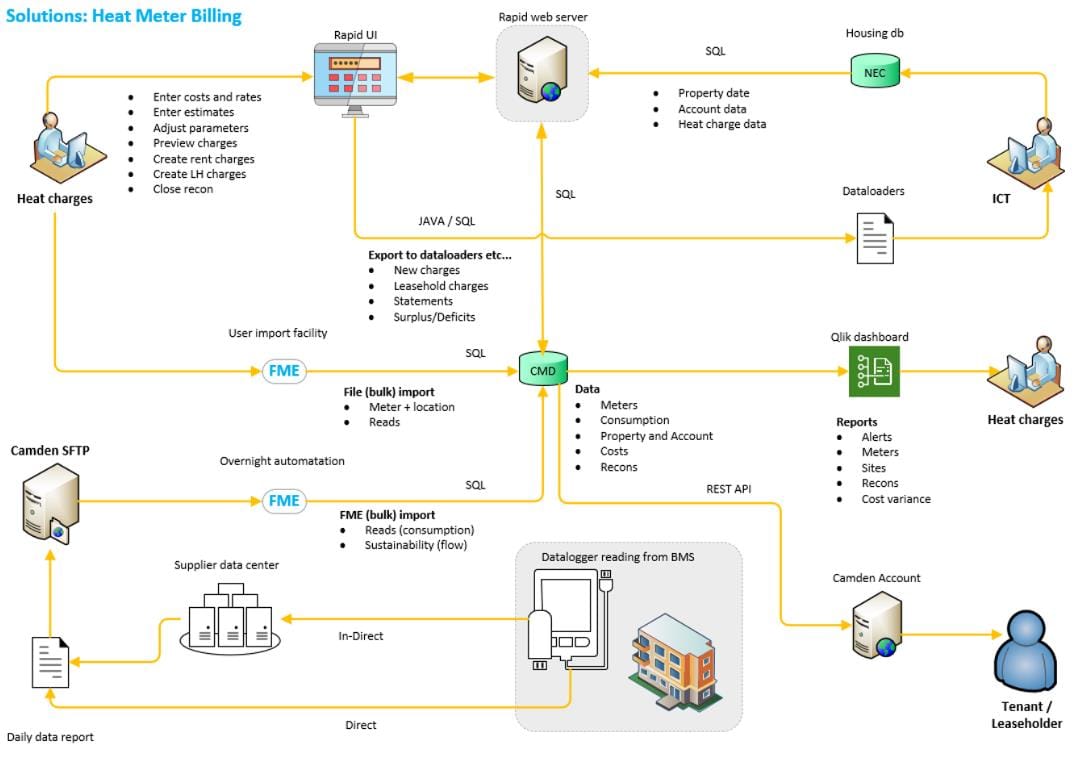Camden Council: Improving energy calculations and compliance
Camden Council's innovative partnership delivers efficient energy billing, saving 251 hours annually, enhancing transparency, and ensuring regulatory compliance, benefiting both the council and residents alike.

Rapid Information Systems/Case studies/Camden Council: Improving energy calculations and compliance
Challenge
Camden Council is a local authority in London that provides heating and hot water to about 15,000 homes through district networks. The council runs the billing function for all these homes in-house, aiming to keep the heat standing charges low for residents and recover the costs of energy provision.
However, the council faced several challenges in managing the energy billing and compliance process, such as:
- Complying with the Heat Network (Metering and Billing) Regulations, which require the installation of metering devices, billing based on consumption, and reporting on heat network details.
- Producing accurate and transparent energy bills for residents, which involve collating data from multiple sources, calculating annual energy charges, tenants’ new weekly heat charge, leaseholder loaders, surplus and deficit files, etc.
- Adapting to the changing factors that affect the energy pricing and provision, such as historical changes, uplifts and caps, business and political decisions, and cladding related concerns.
The council decided to create a bespoke billing solution in 2016 to improve its processes and prepare for an increase in metered properties. Camden partnered with Rapid to review the process and develop a customised product that would automate standardised processes, link with the council’s housing database NEC, and enable residents to view their meter usage data online.
Solution
The solution was a collaborative effort between Rapid and Camden Council. We aimed to create a data-driven solution that would streamline the energy billing and compliance process for local authorities. The solution involved the following steps:
- Understanding stakeholder needs
We conducted workshops with key stakeholders, such as energy officers, housing managers, finance officers, and residents, to understand their challenges, expectations, and preferences. We used their feedback to guide our design and development process. - Critical data identification and system integration
We identified the critical data sources and systems that engaged in the energy billing and compliance process, such as the smart meter readings, the energy costs, the heat network details, and the resident details. We integrated these data sources and systems using API connections to enable seamless data flow and ensure data quality and security. - User-centric prototypes
We developed prototypes using our low-code platform. We incorporated live data and user feedback to align the designs with user objectives. We assessed and refined the prototypes until we achieved the desired functionality and usability. - Forecasting and calculation of energy charges
We developed a solution that used the historical data and the current data to forecast the energy charges for the coming year. The solution also used the smart meter readings to calculate the individual energy consumption and costs for each resident. The solution generated personalised bills and statements for the residents, showing the breakdown of the energy charges and the comparison with the previous year. The solution also created the tenant’s new weekly charge based on their usage and the unit rates. - Reporting and compliance with the Regulations
We developed a solution that used the data from the heat networks and the energy consumption to generate reports and comply with the Regulations. The solution also created the leaseholder file for service charges and leaseholder estimates.
We used a Trello Kanban board to manage the tickets from request to deployment. We conducted extensive User Acceptance Testing to ensure the accuracy and reliability of the solution. We introduced the solution in phases, starting with two sites in summer 2022, followed by 29 sites in 2023. We ran the sites in parallel both manually and through the solution for the first year to verify the results. We also put in place audit checks for the future.
The solution was successfully introduced in 2023 and has already delivered benefits for both staff and residents. The solution enabled the following functionality:
- Calculation of site-specific energy statements, including costs, standard charges, unit rates.
- Interaction of the system with NEC to extract tenants’ heat charges paid with their rent.
- Estimates of usage (average and seasonal) where insufficient data due to resident no-access or faulty equipment.
- Several reconciliation types (full year actuals with uplifts and adjustments, estimates, and ad hoc for part years to accommodate tenancy changes).
- Creation of deficit and surplus files.
- Comparison of costs to enable identification of vulnerable residents and fuel poverty.
- Integration with NEC Housing and a Camden Resident’s Portal, enabling residents to view online month-end heat usage and energy statements.
- Bulk meter data to support current and future BMS analysis.
The model below highlights the dataflows between the Rapid solution and existing systems within Camden Council:

Impact
The product is a data-driven solution that enhances the energy billing and compliance process for local authorities. It has increased the efficiency, effectiveness, and transparency of the process, as well as the energy performance and customer satisfaction of Camden’s heat networks. It has also reduced the risk and liability of non-compliance and boosted the customer loyalty and trust. The product has the following impacts:
- Technological impact
The product reduces manual calculations, increases accuracy, and reduces errors, enables more data analysis as the number of metered homes grows, and integrates distinct functions that benefit multiple teams and residents, such as energy calculations and the Camden Account. The product is an innovative solution that can benefit the not-for-profit social housing sector and has attracted interest from other Local Authorities and housing associations. The solution is working in partnership between Rapid and Camden for a wider roll out. - Budgetary impact
The solution saves staff time and costs, as well as resident costs. For staff, there has been a reduction in the time to produce and mail merge the energy statements for an estate from days and hours to minutes. It also allows the staff to do more in-depth analysis of the meter data and identify high or low users of heat, which provides them with more job variety and development.
Camden estimates that it will save more than 280 staff hours per year for the full year actual recons, which is an 85% reduction compared to the previous Excel method. For residents, the product lowers the standing charges by billing in-house, instead of outsourcing to other suppliers who charge more. Camden estimates that the typical heat standing charge for its residents was about £70 per annum, which covers data charges, repairs and maintenance, administration, and billing. This is much lower than other providers who charge over £100 just for the administration and billing part of the standing charge.
Camden expects that its solution will bring cost savings for residents across the social housing sector if other local authorities and housing associations adopt it.
- Environmental impact
Camden have reported that in 2022-2023, 3,100 metered households had access to their heat usage via a Residential porta online, and this number increased to 4,500 households in 2023-2024 and it is anticipated that this number will continue to increase as the number of metered homes increases each year. - Social impact
The social well-being of the residents has been improved by providing better data analysis and support.
Processing the energy charge calculations in-house keeps the standing charges significantly lower when compared to the services being provided by an external supplier. This keeps the costs lower for the residents, which is extremely important given the cost of living crisis we are all in. The bespoke system has been tailored to accommodate the variety of services that Camden supplies to our residents, along with their different charging types.
Mary Harvey, Charges Controller at the London Borough of Camden
